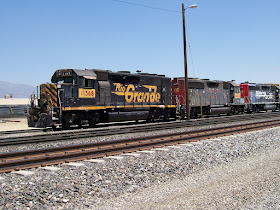 Trainline HO Scale EMD GP9M Locomotive Ready-to-Run - Canadian National
Trainline HO Scale EMD GP9M Locomotive Ready-to-Run - Canadian NationalONE OF OUR MOST REQUESTED LOCOMOTIVES!
Product Features
Ready to Run
Dual Fly Wheels
Knuckle Couplers
Diecast Metal Frame
Quality construction and features
From the Manufacturer
The Electro-Motive Division (EMD) of General Motors was the last major builder to enter the road switcher market, introducing the GP7 (GP for General Purpose) in 1949. In 1954, the more powerful GP9 was unveiled with a 1750 horsepower prime-mover. This became the most successful of the early geeps, with sales of more than 3,800 locos in the U.S. and Canada. As the GP9s were bumped from major freight and passenger trains by newer locos, they began new careers as switchers. Many roads rebuilt them with a low nose to improve forward visibility and they continue to serve in switching, wayfreight and transfer assignments today. This HO Scale model will be a real workhorse on your model railroad, with great features like a heavy diecast metal frame, powerful can motor with flywheel, eight-wheel electrical pick-up and drive, and a working headlight. Fully assembled and ready for service, they come prepainted in a variety of schemes.
An EMD GP9 is a four-axle diesel locomotive built by General Motors' Electro-Motive Division in the United States, and General Motors Diesel in Canada between January, 1954, and August, 1963. US production ended in December, 1959, while an additional thirteen units were built in Canada, including the last two in August, 1963. Power was provided by an EMD 567C sixteen-cylinder engine which generated 1,750 horsepower (1.30 MW).[1] This locomotive type was offered both with and without control cabs; locomotives built without control cabs were called GP9B locomotives. All GP9B locomotives were built in the United States between February, 1954, and December, 1959.
A total of 3,444 units of this locomotive model were built for American railroads, with an additional 646 for Canadian railroads and ten for Mexican railroads. Five units were built for a railroad in Brazil, four units were built for a railroad in Peru and six units were built for a railroad in Venezuela. Of the GP9B, 165 examples were built for American railroads.
There were 40 GP9M units built that are included in the 3,444 units built for United States railroads. A GP9M was built with parts from another older EMD locomotive, either an F unit or a damaged GP7. The use of parts from these older locomotives caused the GP9Ms to have a lower horsepower rating than a GP9. This would be either 1,350 horsepower (1.01 MW) if the donor locomotive was an FT/F2 or 1,500 horsepower (1.12 MW) from F3/F7/GP7 locomotives.
Many rebuilt GP9s remain in service today with shortline railroads and industrial operators. Some remain in rebuilt form on some major Class I railroads, as switcher locomotives. Canadian Pacific Railway and Canadian National Railway still have many in their fleets in 2007 as switcher locomotives.
See Other Canadian National Locomotives: Bachmann HO Scale 2-6-0 Mogul Locomotive - Canadian National
See Other GP-9M Locomotives: Trainline EMD GP9M HO Scale Locomotive - Burlington Northern / Trainline EMD GP9 HO Scale Locomotive - Rio Grande
See More Canadian National Railway News Stories: Talks Between CN And Locomotive Engineers' Union In Canada Break Off With No Settlement / CN Receives Strike Notice From Union Representing Locomotive Engineers In Canada / CN To Implement Wage Increase And Milage Cap For It's Canadian Engineers / CN Reaches 20th Voluntary Mitigation Agreement (VMA), Makes Substantial Strides In EJ&E Integration





























